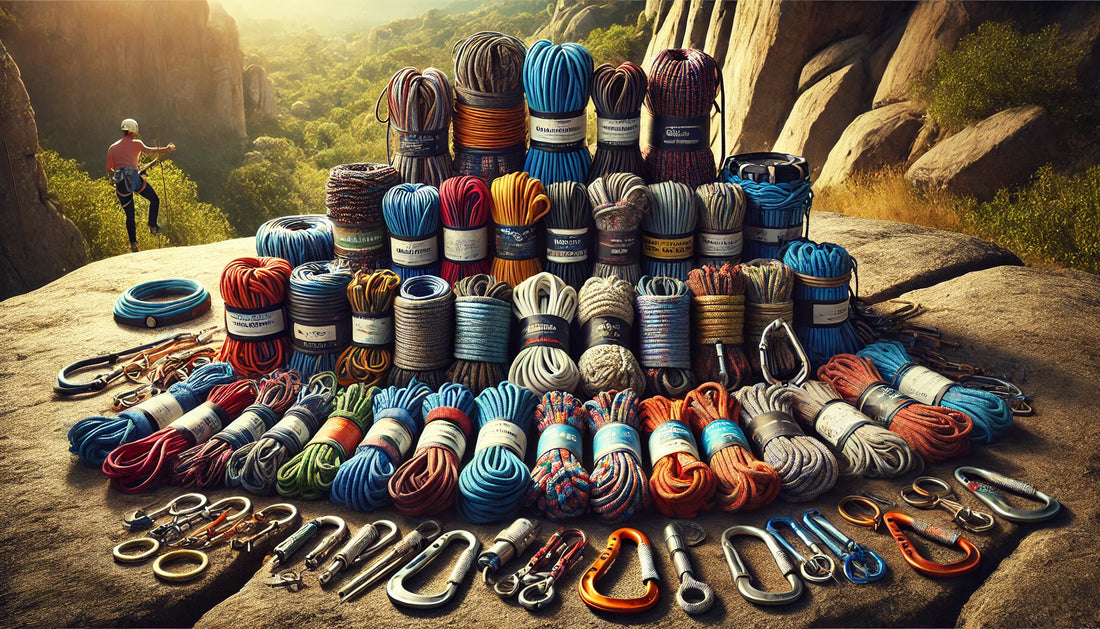Selecting the right climbing rope is crucial for a safe and enjoyable climbing experience. With so many types of ropes available, it can be challenging to know which one is best suited to your style, route, and safety needs. Here’s a guide to help you pick the perfect rope for your next outdoor adventure.
1. Dynamic vs. Static Ropes
Climbing ropes are classified as either dynamic or static, depending on their stretch.
- Dynamic Ropes: These ropes have elasticity, allowing them to absorb the impact of a fall. This makes them ideal for lead climbing, top-roping, and most outdoor climbing scenarios.
- Static Ropes: Designed with minimal stretch, static ropes are used for rappelling, hauling gear, and rescue situations. They are not suitable for lead climbing, as they don’t absorb the energy from a fall.
When planning an outdoor climb, go with a dynamic rope for lead or top-rope climbing.
2. Single, Half, and Twin Ropes
The rope configuration you choose depends on the type of climbing you’ll be doing.
- Single Ropes: These are the most versatile and commonly used ropes. They’re marked with a “1” symbol, indicating they can be used alone. Great for sport climbing, trad climbing, and top-roping, single ropes are usually thicker and more durable.
- Half Ropes: Used in pairs, half ropes are best for multi-pitch routes and trad climbing in alpine environments. Marked with a “1/2” symbol, they allow you to clip each rope to alternate pieces of protection, which reduces rope drag on wandering routes.
- Twin Ropes: Also used in pairs but clipped together through the same piece of protection, twin ropes are marked with an infinity symbol (∞). They’re ideal for alpine and ice climbing, where redundancy is critical, and the ropes’ thinner diameter keeps the weight manageable.
For most outdoor climbing, a single dynamic rope is a solid choice, but for multi-pitch or alpine climbs, half or twin ropes provide added safety.
3. Rope Diameter and Weight
Rope diameter influences weight, durability, and handling. Most ropes range between 8.5mm and 10.5mm in diameter.
- Thicker Ropes (9.8mm – 10.5mm): These ropes are durable and perfect for beginners or those who plan to climb in rugged terrain, as they withstand wear and tear.
- Thinner Ropes (8.5mm – 9.4mm): These lighter ropes are ideal for advanced climbers focused on reducing weight. However, they’re less durable and require skilled handling.
For general outdoor climbing, a rope in the 9.4mm-10mm range provides a good balance of durability and weight.
4. Length of the Rope
Climbing ropes come in various lengths, with 60m and 70m being the most common.
- 60m Ropes: These are versatile for many climbing areas. They’re generally sufficient for most single-pitch routes, but be sure to check route lengths at your destination.
- 70m Ropes: Useful for longer routes or for multi-pitch climbing, a 70m rope provides added reach and can often be doubled over to make rappels easier.
- 80m and Beyond: For specialty routes, particularly in areas with long pitches, longer ropes are sometimes needed. However, they’re heavier and less common.
If you’re uncertain, a 70m rope offers the most flexibility for various climbing situations.
5. Dry Treatment and Weather Resistance
If you’re climbing in wet or icy conditions, a dry-treated rope is essential. Dry-treated ropes resist moisture, helping to prevent the rope from becoming heavy or weakened by water absorption.
- Dry Core: Some ropes have a treated core to prevent water absorption.
- Dry Sheath: A treated sheath keeps the outer layer of the rope dry. Some ropes have both a dry-treated core and sheath, providing full protection.
For alpine, ice, or any wet-weather climbs, opt for a dry-treated rope. For dry conditions, a non-treated rope is usually sufficient.
6. Rope Safety Ratings and Certifications
When selecting a climbing rope, look for certifications from UIAA (International Climbing and Mountaineering Federation) and EN (European Norm). These certifications ensure that the rope meets high standards for durability, fall capacity, and impact force.
- Fall Rating: Indicates the number of falls the rope can withstand. Higher ratings are better for routes with frequent falls.
- Impact Force: Measures the force transferred to the climber and gear during a fall. Lower impact force reduces the strain on both the climber and protection.
Certified ropes meet stringent safety standards and are essential for safe climbing.
7. Caring for Your Climbing Rope
Proper care can extend the life of your rope and keep it safe for use.
- Avoid stepping on your rope: Dirt and grit can weaken the fibers.
- Store it properly: Keep your rope in a cool, dry place, out of direct sunlight.
- Inspect regularly: Check for fraying, cuts, or areas where the core feels thin. Retire the rope if you notice any damage.
Choosing the right rope is essential for safe and enjoyable outdoor climbing. Consider your climbing style, the terrain, and the environmental conditions when selecting a rope, and you’ll be set for success. If you’re building a home wall for extra training, explore our climbing hold collections and wall design instructions to enhance your practice.

